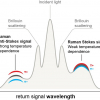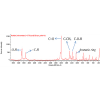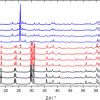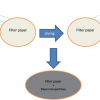Marleen de Veij,a Peter Vandenabeeleb and Luc Moensa
aGhent University, Laboratory of Analytical Chemistry, Proeftuinstraat 86, B-9000 Ghent, Belgium. E-mail: [email protected]
bGhent University, Department of Archaeology and Ancient History of Europe, Belgium
Introduction
According to the World Health Organisation (WHO), a counterfeit drug is one that is deliberately and fraudulently mislabelled with respect to identity and/or source. Counterfeiting can apply to both branded and generic products; counterfeit products may include products with correct or wrong ingredients, without active ingredients, with insufficient active ingredient or fake packaging.
During the last decade, the amount of counterfeit drugs on the worldwide market has rapidly increased. It is difficult to determine the exact scale of this problem, since not all counterfeit drugs are reported or even detected. The drugs that are often counterfeited can be divided into two groups, depending on the region where they are brought onto the market. In developed countries, expensive life-style drugs like Viagra® and Cialis® are often counterfeited, while in developing countries, drugs to treat life-threatening illnesses like malaria are often counterfeited.
The first step in detecting counterfeit drugs is the careful visual inspection of the package and label, since even the smallest modifications may indicate a potential counterfeit. Since counterfeiters are becoming increasingly more sophisticated, additional analytical techniques are necessary to detect these counterfeits. So far, several analytical techniques have been used to detect counterfeit drugs, for instance high-performance liquid chromatography (HPLC), thin-layer chromatography (TLC), X-ray diffraction (XRD), near infrared (NIR) spectroscopy or colorimetric reactions. The downside of these methods is that they require sample preparation or that they only focus on a single component.
The use of Raman spectroscopy in the pharmaceutical field has been increasing over the last few years. Raman spectroscopy has some specific benefits, which can be very useful for the detection of counterfeit drugs: a Raman spectrum can be recorded rapidly without any sample preparation. Moreover, not only does a Raman spectrum provide information about the active ingredient present in the drug, but also a Raman spectrum contains information on its concentration and allows identification of excipients present in the drug. So far, this technique has been used for the detection of different kinds of illicit drugs, such as cocaine, heroin and ecstasy, and also for the detection of counterfeit antimalarial and Viagra® tablets. This article will demonstrate the use of Raman spectroscopy as a fast and easy detection system for different counterfeit erectile dysfunction drugs.
Three different genuine erectile dysfunction drugs are available on the market: Viagra®, Cialis® and Levitra®. Viagra® is the most commonly counterfeited drug, but the amount of counterfeit Cialis® has rapidly increased over the last few years. The possible counterfeits analysed consisted of two Viagra® tablets, SEYAGRA-GEL containing the same active ingredient as Viagra® and two tablets claiming to contain the same active ingredient as Cialis®.


















